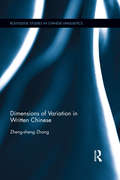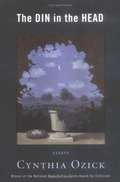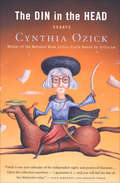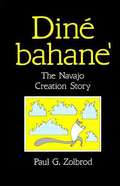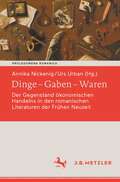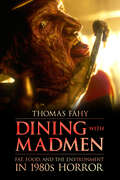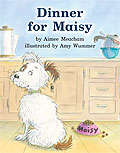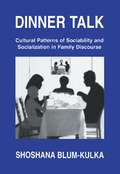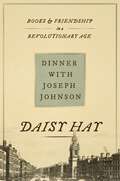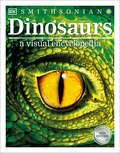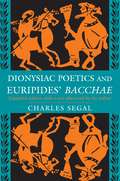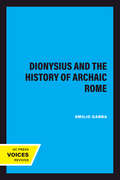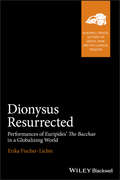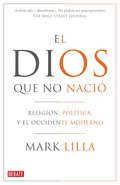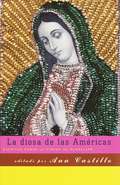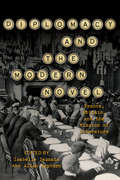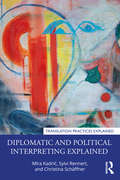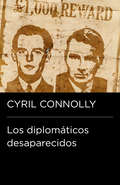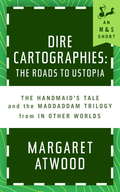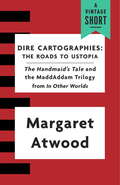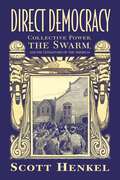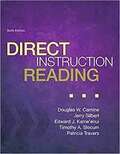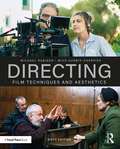- Table View
- List View
Dimensions of Variation in Written Chinese (Routledge Studies In Chinese Linguistics Ser.)
by Zheng-Sheng ZhangDimensions of Variation in Written Chinese uses a corpus-based, multi-dimensional model to account for variation in written Chinese. Using statistical method and two-dimensional visual representation, it provides a concrete and objective view of the internal variation in written Chinese. This book is a timely work that addresses the growing interest in quantitative genre analysis and how knowledge thus gained can contribute to the teaching as well as understanding of the Chinese language. Zheng-sheng Zhang is Professor of Chinese at San Diego State University. He has been a long-term editor of the Journal of Chinese Language teachers Association (now known as Chinese as a Second Language) and is a respected researcher in the field of Chinese linguistics.
The Din in the Head: Essays
by Cynthia OzickOne of America's foremost novelists and critics, Cynthia Ozick has won praise and provoked debate for taking on challenging literary, historical, and moral issues. Her new collection of spirited essays focuses on the essential joys of great literature, with particular emphasis on the novel. With razor-sharp wit and an inspiring joie de vivre, she investigates unexpected byways in the works of Leo Tolstoy, Saul Bellow, Helen Keller, Isaac Babel, Sylvia Plath, Susan Sontag, and others. In a posthumous and hilariously harassing "(Unfortunate) Interview with Henry James," Ozick's hero is shocked by a lady reporter. In "Highbrow Blues" and in reflections on her own early fiction, she writes intimately of "the din in our heads, that relentless inner hum," and the curative power of literary imagination. The Din in the Head is sure to please fans of Ozick, win her new readers, and excite critical controversy and acclaim.
The Din in the Head: Essays
by Cynthia OzickA collection of essays on the joys of great literature from the New York Times–bestselling author and winner of the National Book Critics Circle Award. One of America&’s foremost novelists and critics, Cynthia Ozick has won praise and provoked debate for taking on challenging literary, historical, and moral issues. Her new collection of spirited essays focuses on the essential joys of great literature, with particular emphasis on the novel. With razor-sharp wit and an inspiring joie de vivre, she investigates unexpected byways in the works of Leo Tolstoy, Saul Bellow, Helen Keller, Isaac Babel, Sylvia Plath, Susan Sontag, and others. In a posthumous and hilariously harassing &“(Unfortunate) Interview with Henry James,&” Ozick&’s hero is shocked by a lady reporter. In &“Highbrow Blues,&” and in reflections on her own early fiction, she writes intimately of &“the din in our heads, that relentless inner hum,&” and the curative power of literary imagination. The Din in the Head is sure to please fans of Ozick, win her new readers, and excite critical controversy and acclaim. &“Open the collection anywhere—I guarantee it—and you will feel the bite of her distinctive voice.&” —Sven Birkerts, Los Angeles Times &“The passion that fills these essays is invigorating. In our age of irony and commercial pandering, we need writers like Ozick.&” —Danielle Chapman, Chicago Tribune
Diné Bahane': The Navajo Creation Story
by Paul G. ZolbrodThis is the most complete version of the Navajo creation story to appear in English since Washington Matthews' Navajo Legends of 1847. Zolbrod's new translation renders the power and delicacy of the oral storytelling performance on the page through a poetic idiom appropriate to the Navajo oral tradition. Zolbrod's book offers the general reader a vivid introduction to Navajo culture. For students of literature this book proposes a new way of looking at our literary heritage.
Dinge – Gaben – Waren: Der Gegenstand ökonomischen Handelns in den romanischen Literaturen der Frühen Neuzeit (Prolegomena Romanica. Beiträge zu den romanischen Kulturen und Literaturen)
by Annika Nickenig Urs UrbanDinge tauchen in der Literatur der Frühen Neuzeit in ganz unterschiedlichen Zusammenhängen auf – sie werden getauscht, verschenkt oder geraubt. Dabei haben sie – jenseits ihres ‚Eigensinns‘ – je andere Funktion und Bedeutung: als handlungstragendes Element, als Mittel der Figurencharakterisierung oder als Gegenstand ökonomischen Handelns. Trotz ihrer Präsenz und ihrer großen Bedeutung vor allem für die ‚Ökonomie der Literatur‘ sind indes die Dinge (anders als Subjekte oder Modalitäten ökonomischen Handelns) von den Literaturwissenschaften bislang kaum untersucht worden. Der Sammelband schließt an aktuelle Forschungen zur ‚materiellen Kultur‘ an und widmet sich erstmals konsequent den Dingen und Gegenständen, die in literarischen Texten der romanischen Literaturen von der Renaissance bis zum 18. Jahrhundert zur Sprache kommen.
Dining with Madmen: Fat, Food, and the Environment in 1980s Horror
by Thomas FahyIn Dining with Madmen: Fat, Food, and the Environment in 1980s Horror, author Thomas Fahy explores America’s preoccupation with body weight, processed foods, and pollution through the lens of horror. Conspicuous consumption may have communicated success in the eighties, but only if it did not become visible on the body. American society had come to view fatness as a horrifying transformation—it exposed the potential harm of junk food, gave life to the promises of workout and diet culture, and represented the country’s worst consumer impulses, inviting questions about the personal and environmental consequences of excess.While changing into a vampire or a zombie often represented widespread fears about addiction and overeating, it also played into concerns about pollution. Ozone depletion, acid rain, and toxic waste already demonstrated the irrevocable harm being done to the planet. The horror genre—from A Nightmare on Elm Street to American Psycho—responded by presenting this damage as an urgent problem, and, through the sudden violence of killers, vampires, and zombies, it depicted the consequences of inaction as terrifying.Whether through Hannibal Lecter’s cannibalism, a vampire’s thirst for blood in The Queen of the Damned and The Lost Boys, or an overwhelming number of zombies in George Romero’s Day of the Dead, 1980s horror uses out-of-control hunger to capture deep-seated concerns about the physical and material consequences of unchecked consumption. Its presentation of American appetites resonated powerfully for audiences preoccupied with body size, food choices, and pollution. And its use of bodily change, alongside the bloodlust of killers and the desolate landscapes of apocalyptic fiction, demanded a recognition of the potentially horrifying impact of consumerism on nature, society, and the self.
Dinner for Maisy (Fountas & Pinnell LLI Green #Level H, Lesson 85)
by Aimee MeachamFountas and Pinnell Leveled Literacy Intervention Green System -- 1st Grade
Dinner Talk: Cultural Patterns of Sociability and Socialization in Family Discourse
by Shoshana Blum-KulkaDinner Talk draws upon the recorded dinner conversations of, and extensive interviews with, native Israeli, American Israeli, and Jewish American middle-class families to explore the cultural styles of sociability and socialization in family discourse. The thesis developed is that family dinners in Western middle-class homes fulfill important functions of sociability for all participants and, at the same time, serve as crucial sites of socialization for children through language and for language use. The book demonstrates the way talk at dinner constructs, reflects, and invokes familial, social, and cultural identities and provides social support for easing the passage of children into adult discourse worlds. Family discourse at dinner emerges as a particularly rich site for discursive socialization and a highly meaningful enactment of sociable behavior in culturally patterned ways. Although all the families studied have a commom Eastern European background, Israeli and Jewish American families are shown to differ extensively in their interactional styles, in ways that enact historically different, community-related interpretations of the dialectics of continuity and change. Native Israeli, American Israeli, and Jewish American families differ culturally in the ways they negotiate issues of power, independence, and involvement through various speech activities such as the choice and initiation of topics, conversational story-telling, naming practices, metapragmatic discourse, politeness strategies, and in immigrant, bilingual families, language choice and code switching. Dinner Talk demonstrates the unique interactional style of each of the groups, linking the observed communication patterns to the ideological, sociocultural, and historical contexts of their respective communities.This innovative study of family discourse from a cross-cultural perspective will appeal to students and specialists in sociolinguistics, communication, anthropology, child language, and family and Jewish studies, as well as to all interested in patterns of communication within families.
Dinner with Joseph Johnson: Books and Friendship in a Revolutionary Age
by Daisy HayA fascinating portrait of a radical age through the writers associated with a London publisher and bookseller—from William Wordsworth and Mary Wollstonecraft to Benjamin FranklinOnce a week, in late eighteenth-century London, writers of contrasting politics and personalities gathered around a dining table. The veal and boiled vegetables may have been unappetising but the company was convivial and the conversation brilliant and unpredictable. The host was Joseph Johnson, publisher and bookseller: a man at the heart of literary life. In this book, Daisy Hay paints a remarkable portrait of a revolutionary age through the connected stories of the men and women who wrote it into being, and whose ideas still influence us today.Johnson’s years as a publisher, 1760 to 1809, witnessed profound political, social, cultural and religious changes—from the American and French revolutions to birth of the Romantic age—and many of his dinner guests and authors were at the center of events. The shifting constellation of extraordinary people at Johnson’s table included William Blake, William Wordsworth, Samuel Taylor Coleridge, Benjamin Franklin, the scientist Joseph Priestly and the Swiss artist Henry Fuseli, as well as a group of extraordinary women—Mary Wollstonecraft, the novelist Maria Edgeworth, and the poet Anna Barbauld. These figures pioneered revolutions in science and medicine, proclaimed the rights of women and children and charted the evolution of Britain’s relationship with America and Europe. As external forces conspired to silence their voices, Johnson made them heard by continuing to publish them, just as his table gave them refuge.A rich work of biography and cultural history, Dinner with Joseph Johnson is an entertaining and enlightening story of a group of people who left an indelible mark on the modern age.
The Dinosaur Alphabet Book (Jerry Pallotta's Alphabet Books)
by Jerry PallottaThe perfect way to introduce children to the fascinating world of dinosaurs. Full of interesting facts--did you know some dinosaurs had sharp front teeth while others had no front teeth at all? This alphabet book explores both the known and the not-so-well known dinosaurs.Meet the heterodontosaurus (one of the smallest known to exist), the megalosaurus (the first dinosaur ever discovered), the iguanodon, the ultrasaurus, and more!Once again, Jerry Pallotta and Ralph Masiello have combined their talents to create a unique children's book that will inform and entertain young readers.
Dinosaurs: A Visual Encyclopedia, 2nd Edition (DK Children's Visual Encyclopedias)
by DKBe brave as you meet the most incredible creatures to ever walk the Earth in this top-selling book.The ultimate visual encyclopedia introduces a huge variety of record-breaking dinosaurs in mind-blowing detail.Dinosaurs: A Visual Encyclopedia charts the entire history of life on our planet, from the very first life forms through the range of prehistoric creatures and the diverse species of the Ice Ages. This curious mixture of the weird and wonderful is shown in stunning expert-verified reconstructed images alongside fascinating fact files and additional information about habitat, diet, and behavior. You might already be able to tell your Tyrannosaurus Rex from Triceratops, but have you ever seen horse-eating birds and millipedes the size of crocodiles? Then look no further.Other topics such as evolution, fossilization, and climate change are explored in-depth to build up a complete picture of the dinosaur era.Dinosaur fans and fossil hunters, what are you waiting for?
Dionysiac Poetics and Euripides' Bacchae: Expanded Edition
by Charles SegalIn his play Bacchae, Euripides chooses as his central figure the god who crosses the boundaries among god, man, and beast, between reality and imagination, and between art and madness. In so doing, he explores what in tragedy is able to reach beyond the social, ritual, and historical context from which tragedy itself rises. Charles Segal's reading of Euripides' Bacchae builds gradually from concrete details of cult, setting, and imagery to the work's implications for the nature of myth, language, and theater. This volume presents the argument that the Dionysiac poetics of the play characterize a world view and an art form that can admit logical contradictions and hold them in suspension.
Dionysius and The History of Archaic Rome (Sather Classical Lectures #56)
by Emilio GabbaIn The History of Archaic Rome, Dionysius purposely viewed Roman history as an embodiment of all that was best in Greek culture. Gabba places Dionysius's remarkable thesis in its cultural context, comparing this author with other ancient historians and evaluating Dionysius's treatment of his sources.In truth, the last decades B.C. made the historian's task an enormous challenge. On the one hand, the ancient writers knew Rome to be the greatest empire the world had seen, seemingly impregnable in military power and still capable of expansion. On the other hand, they were acutely aware that it recently had barely survived half a century of civil strife.Gabba recalls to us how little was confidently known of Rome's actual origins in an illuminating examination of Dionysius's methodology as a historian.
Dionysus Resurrected: Performances of Euripides' The Bacchae in a Globalizing World (Blackwell-Bristol Lectures on Greece, Rome and the Classical Tradition)
by Erika Fischer-LichteDionysus Resurrected analyzes the global resurgence since the late 1960s of Euripides’ The Bacchae. By analyzing and contextualizing these modern day performances, the author reveals striking parallels between transformational events taking place during the era of the play’s revival and events within the play itself. Puts forward a lively discussion of the parallels between transformational eventsduring the era of the play’s revival and events within the play itself The first comparative study to analyse and contextualize performances of The Bacchae that took place between 1968 and 2009 from the United States, Africa, Latin America, Europe and Asia Argues that presentations of the play not only represent liminal states but also transfer the spectators into such states Contends that the play’s reflection on various stages of globalization render the tragedy a contemporary play Establishes the importance of The Bacchae within Euripides’ work as the only extant tragedy in which the god Dionysus himself appears, not just as a character but as the protagonist
El Dios que no nació: Religión, política y el Occidente moderno
by Mark LillaUn ensayo agudo e implacable sobre el choque entre política y religión en las sociedades occidentales. Vivimos tiempos en los que la religión intenta con ahínco volver a gobernar territorios hace tiempo conquistados por la política. No es un afán novedoso, pero resulta preocupante cómo algunas democracias aceptan ver mermada la laicidad por la que lucharon. La mayoría de las civilizaciones nacieron y se desarrollaron en torno a un mito fundacional que servía para organizar las vidas de sus miembros al tiempo que aislaba el hecho político, dejándolo en un segundo plano siempre tutelado por la divinidad. No parecía posible perturbar el orden de dichos designios hasta que en la Europa del siglo XVI se abrió la grieta por la que se filtraría la separación de política y religión a la que obedecen nuestras democracias y que posibilitaron la convivencia de acuerdo a leyes creadas por los hombres en lugar de las leyes de algún dios. Mark Lilla, siguiendo la estirpe intelectual de Hobbes, Locke, Rousseau, Hume o Kant, nos ayuda a comprender la magnitud de este desafío y el precario equilibrio que lo sostiene, pues el impulso de volver a unir lo que una vez separó el hombre reaparece con frecuencia en la historia del pensamiento europeo y muy especialmente en la segunda mitad del siglo XX, donde el intento de conciliar la política con la religión derivó en peligrosos mesianismos de mortíferas consecuencias. Revelador y polémico, El dios que no nació nos previene sobre la necesidad de protegernos de las invasiones religiosas que pretenden acabar con el legado de la Ilustración, representado por los pensadores occidentales que encontraron el camino para liberar la política de la autoridad de dios. Una exitosa pero frágil construcción que es necesario conservar.
La diosa de las Américas
by Ana CastilloUna ilustradora colección de escritos en torno al icono más grande de la fe latinoamericana, por algunos de los más importantes escritores latinos contemporáneos. Santa patrona de México, diosa maternal, protectora divina, el símbolo de la Virgen de Guadalupe ha sido reverenciado en el mundo entero. En esta colección, Ana Castillo ha reunido ensayos originales, escritos históricos, ficción, drama y poesía tan diversos como el modo en que cada individuo celebra a esta poderosa deidad. Con obras de: Sandra Cisneros, Clarissa Pinkola Estés, Ph.D., Rosario Ferré, Francisco Goldman, Richard Rodríguez, Elena Poniatowska, y 21 escritores extraordinarios.
Diplomacy and the Modern Novel: France, Britain, and the Mission of Literature
by Isabelle Daunais and Allan HepburnBetween 1900 and 1960, many writers in France and Britain either had parallel careers in diplomatic corps or frequented diplomatic circles: Paul Claudel, Albert Cohen, Lawrence Durrell, Graham Greene, John le Carré, André Malraux, Nancy Mitford, Marcel Proust, and others. What attracts writers to diplomacy, and what attracts diplomats to publishing their experiences in memoirs or novels? Like novelists, diplomats are in the habit of describing situations with an eye for atmosphere, personalities, and looming crises. Yet novels about diplomats, far from putting a solemn face on everything, often devolve into comedy if not outright farce. Anachronistic yet charming, diplomats take the long view of history and social transformation, which puts them out of step with their times – at least in fiction. In this collection of essays, eleven contributors reflect on diplomacy in French and British novels, with particular focus on temporality, style, comedy, characterization, and the professional liabilities attached to representing a state abroad. With archival examples as evidence, the essays in this volume indicate that modern fiction, especially fiction about diplomacy, is a response to the increasing speed of communication, the decline of imperial power, and the ceding of old ways of negotiating to new.
Diplomatic and Political Interpreting Explained (Translation Practices Explained)
by Mira Kadrić Sylvi Rennert Christina SchäffnerThe role of the interpreter at international meetings of politicians and diplomats is a critical one. This book examines the history of diplomacy and diplomatic interpreting as well as the rules and realities of modern diplomatic relations. Building on interviews with interpreters, diplomats and politicians, it examines language as a tool of diplomatic and political communication, the role of interpreters in diplomacy, and the different forms of interaction and communicative behaviour interpreters face and exhibit. The book covers the different ways in which interpreters manage information, expressivity, and interaction, and what diplomats think about it. Each chapter presents key concepts and definitions; examples from existing literature are combined with interviews conducted with professional interpreters as well as seasoned diplomats and politicians to illustrate their relevance in interpreting practice. With activities for group work and self-study, including analysis and discussion of real-life interpreted diplomatic or political events, this book offers a range of interpreting exercises that encourage students to apply the different strategies discussed in the book. Weaving together the voices of interpreters, diplomats, and politicians with a systematic look at the theory and practice of interpreting in diplomatic settings, this is not only an essential textbook for interpreting students and educators but will also be of interest to professional interpreters and students and scholars of politics and international relations. Additional resources are available on the Routledge Translation Studies Portal: http://routledgetranslationstudiesportal.com
Los diplomáticos desaparecidos (Colección Endebate #Volumen)
by Cyril ConnollyLa crónica de la misteriosa desaparición de los dos primeros miembros del círculo de Cambridge. El 25 de mayo de 1951, Guy Burgess y Donald Maclean, dos funcionarios británicos, desaparecieron sin dejar rastro y dieron inicio al mito de los cinco de Cambridge, los brillantes jóvenes captados por la inteligencia soviética en el Cambridge de los años treinta. Aun conmocionado por la desaparición, y mucho antes de que la Unión Soviética admitiera que les había cogido, Cyril Connolly escribió este fascinante y perspicaz retrato de los dos, intentando adivinar qué había pasado con los diplomáticos que desaparecieron.
Dire Cartographies
by Margaret AtwoodIn honor of the thirtieth anniversary of The Handmaid's Tale: Margaret Atwood describes how she came to write her utopian, dystopian works. The word "utopia" comes from Thomas More's book of the same name--meaning "no place" or "good place,"" or both. In "Dire Cartographies," from the essay collection In Other Worlds, Atwood coins the term "ustopia,"" which combines utopia and dystopia, the imagined perfect society and its opposite. Each contains latent versions of the other. Following her intellectual journey and growing familiarity with ustopias fictional and real, from Atlantis to Avatar and Beowulf to Berlin in 1984 (and 1984), Atwood explains how years after abandoning a PhD thesis with chapters on good and bad societies, she produced novel-length dystopias and ustopias of her own. "My rules for The Handmaid's Tale were simple," Atwood writes. "I would not put into this book anything that humankind had not already done, somewhere, sometime, or for which it did not already have the tools." With great wit and erudition, Atwood reveals the history behind her beloved creations.
Dire Cartographies: The Roads to Ustopia and The Handmaid's Tale (A Vintage Short)
by Margaret AtwoodIn honor of the thirtieth anniversary of The Handmaid's Tale: Margaret Atwood describes how she came to write her utopian, dystopian works. The word "utopia" comes from Thomas More's book of the same name--meaning "no place" or "good place," or both. In "Dire Cartographies," from the essay collection In Other Worlds, Atwood coins the term "ustopia," which combines utopia and dystopia, the imagined perfect society and its opposite. Each contains latent versions of the other. Following her intellectual journey and growing familiarity with ustopias fictional and real, from Atlantis to Avatar and Beowulf to Berlin in 1984 (and 1984), Atwood explains how years after abandoning a PhD thesis with chapters on good and bad societies, she produced novel-length dystopias and ustopias of her own. "My rules for The Handmaid's Tale were simple," Atwood writes. "I would not put into this book anything that humankind had not already done, somewhere, sometime, or for which it did not already have the tools." With great wit and erudition, Atwood reveals the history behind her beloved creations.
Dire Straits
by Elizabeth Jane BellamyEngland became a centrally important maritime power in the early modern period, and its writers - acutely aware of their inhabiting an island - often depicted the coastline as a major topic of their works. However, early modern English versifiers had to reconcile this reality with the classical tradition, in which the British Isles were seen as culturally remote compared to the centrally important Mediterranean of antiquity. This was a struggle for writers not only because they used the classical tradition to legitimate their authority, but also because this image dominated cognitive maps of the oceanic world.As the first study of coastlines and early modern English literature, Dire Straits investigates the tensions of the classical tradition's isolation of the British Isles from the domain of poetry. By illustrating how early modern English writers created their works in the context of a longstanding cultural inheritance from antiquity, Elizabeth Jane Bellamy offers a new approach to the history of early modern cartography and its influences on literature.
Direct Democracy: Collective Power, the Swarm, and the Literatures of the Americas (Caribbean Studies Series)
by Scott HenkelWinner of a 2018 C. L. R. James Award for a Published Book for Academic or General Audiences from the Working-Class Studies Association Beginning with the Haitian Revolution, Scott Henkel lays out a literary history of direct democracy in the Americas. Much research considers direct democracy as a form of organization fit for worker cooperatives or political movements. Henkel reinterprets it as a type of collective power, based on the massive slave revolt in Haiti. In the representations of slaves, women, and workers, Henkel traces a history of power through the literatures of the Americas during the long nineteenth century.Thinking about democracy as a type of power presents a challenge to common, often bureaucratic and limited interpretations of the term and opens an alternative archive, which Henkel argues includes C. L. R. James's The Black Jacobins, Walt Whitman's Democratic Vistas, Lucy Parsons's speeches advocating for the eight-hour workday, B. Traven's novels of the Mexican Revolution, and Marie Vieux Chauvet's novella about Haitian dictatorship.Henkel asserts that each writer recognized this power and represented its physical manifestation as a swarm. This metaphor bears a complicated history, often describing a group, a movement, or a community. Indeed it conveys multiplicity and complexity, a collective power. This metaphor's many uses illustrate Henkel's main concerns, the problems of democracy, slavery, and labor, the dynamics of racial repression and resistance, and the issues of power which run throughout the Americas.
Direct Instruction Reading
by Douglas W. Carnine Edward J. Kame'Enui Timothy A. Slocum Patricia A. TraversNote: This is the loose-leaf version of Direct Instruction Reading and does not include access to the Enhanced Pearson eText. To order the Enhanced Pearson eText packaged with the loose-leaf version, use ISBN 0133827089. Novice and expert teachers alike get the detailed guidance they need to be successful teaching any child who struggles with reading in the alphabetic writing system. Unique in its approach of leaving little to chance or guesswork, Direct Instruction Reading details how to teach, what to teach, why it is important to teach it, when to teach it, how long, how often, at what starting point in time, and to what criterion level of performance. For example, teaching format specify a) example words to teach; b) explicit directions for modeling how to read the words; c) explicit directions for how to guide students in their responses to teaching to teacher prompts; and d) explicit wording for correcting student errors. The book is designed to give both novice teachers with limited or no teaching experience, as well as the expert teacher with extensive teaching experience the detailed guidance they need to be successful teaching any child who struggles with reading in the alphabetic writing system. This new edition features chapter Learning Outcomes; a new chapter on Response to Intervention (RtI); information relating the Common Core State Standards (CCSS) to the Direct Instruction approach; web resources, video links, and other general research reference sources; explicit references and links to the most rigorous research available through the Institute of Education Sciences (IES); and updated research throughout. The Enhanced Pearson eText features embedded video.
Directing: Film Techniques and Aesthetics
by Michael Rabiger Mick Hurbis-CherrierDirecting: Film Techniques and Aesthetics is a comprehensive exploration into the art and craft of directing for film and television. It’s filled with practical advice, essential technical information, and inspiring case studies for every stage of production. This book covers the methods, technologies, thought processes, and judgments that a director must use throughout the fascinating process of making a film, and concentrates on developing the human aspects of cinema to connect with audiences.The fully revised and updated 6th edition features new sections on using improvisation, the development of characters for long form television series, visual design, the role of the digital imaging technician, film promotion and distribution, alongside expanded information on contemporary color grading tools, stylistic approaches and genre, workflows, blocking scenes for the camera and more. The book emphasizes independent and short form cinema which allows cutting-edge creativity and professionalism on shoestring budgets. Recognizing that you learn best by doing, it includes dozens of practical hands-on projects and activities to help you master technical and conceptual skills. Just as important as surmounting technological hurdles is the conceptual and authorial side of filmmaking. This book provides an unusually clear view of the artistic process, particularly in working with actors and principle crew members. It offers eminently practical tools and exercises to help you develop your artistic identity, find credible and compelling stories, choose and work with your cast and hone your narrative skills. Directing shows you how to surpass mere technical proficiency and become a storyteller with a distinctive voice and style. The accompanying companion website includes film analysis exercises, shooting projects, checklists and assignment forms, analytical questionnaires, updated production forms and logs for all phases of a project with links to additional resources and set safety advice.
